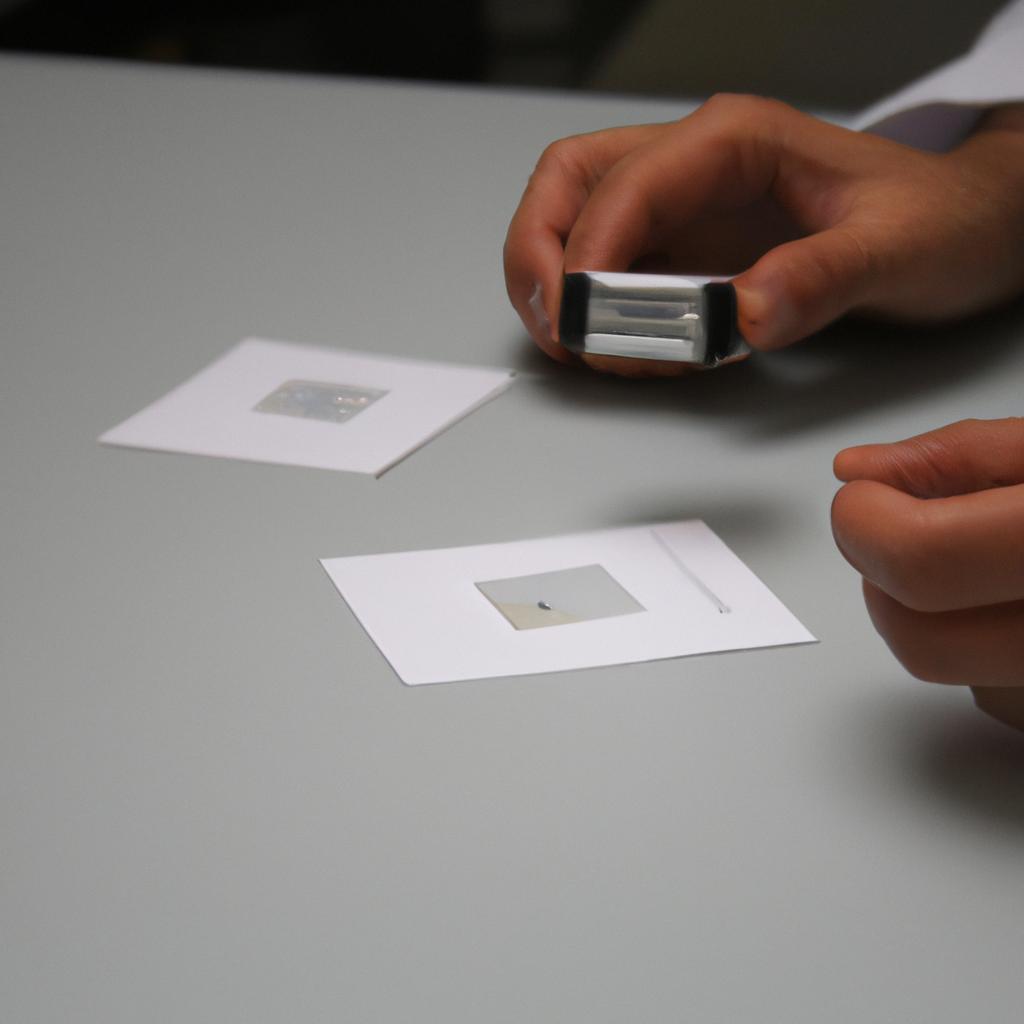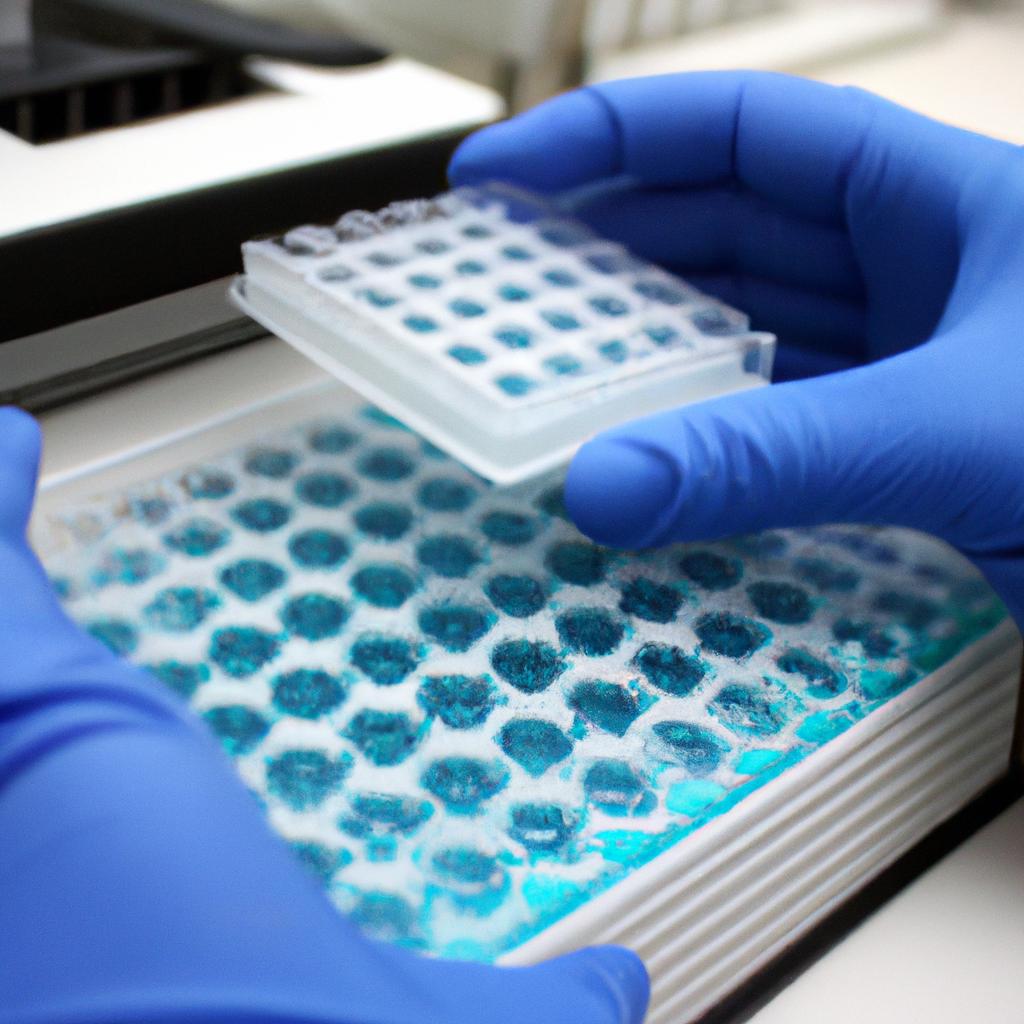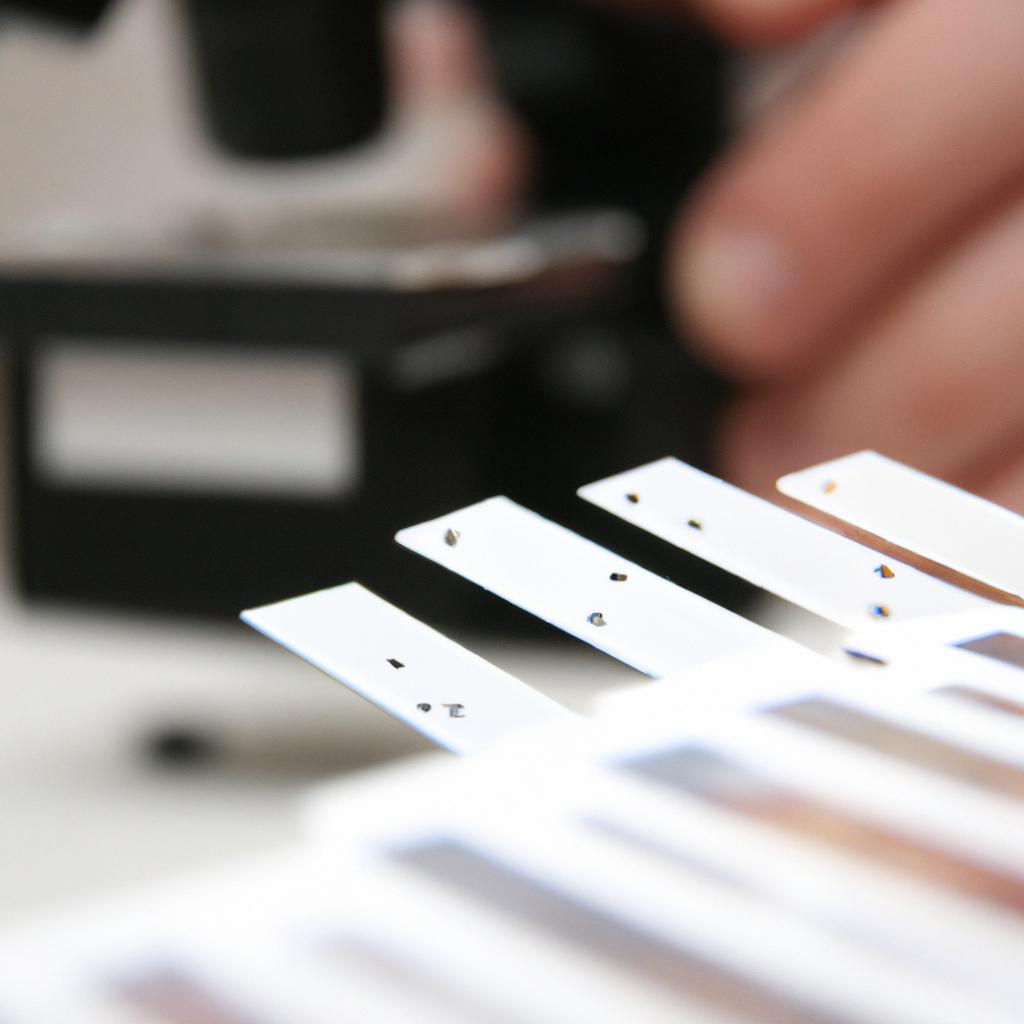Infectious organisms pose a significant challenge in veterinary clinical pathology, particularly when it comes to cellular morphology. This field of study focuses on the examination and analysis of animal cells to diagnose diseases and identify infectious agents. One example that highlights the importance of understanding cellular morphology in veterinary clinical pathology is the case of a feline patient presenting with persistent fever and lethargy. Upon microscopic examination, abnormal cell changes were observed, leading to the identification of an underlying bacterial infection. In this article, we will delve into the intricacies of infectious organisms within the context of veterinary clinical pathology, exploring their impact on cellular morphology.
Cellular morphology plays a crucial role in diagnosing infections caused by various microorganisms in veterinary medicine. The ability to accurately assess and interpret changes in cell structure and appearance enables veterinarians to detect pathogenic agents such as bacteria, viruses, fungi, or parasites. Through meticulous evaluation under a microscope, abnormalities such as alterations in cell shape, size, coloration, staining patterns, or presence of intracellular pathogens can be identified. These observations aid in determining not only the type but also the severity and progression of infectious diseases in animals.
Understanding how different infectious organisms affect cellular morphology is essential for accurate diagnosis and effective treatment strategies. By recognizing specific morph By recognizing specific morphological changes associated with different infectious organisms, veterinarians can make informed decisions regarding treatment options. For example, certain bacteria may cause distinct cellular changes, such as the presence of intracellular inclusions or characteristic staining patterns, which can help differentiate between bacterial infections. Similarly, viral infections often result in alterations in cell size and shape, along with the presence of viral cytopathic effects.
Moreover, understanding cellular morphology allows for the identification of potential complications or secondary infections that may arise during the course of an initial infection. By monitoring changes in cell appearance over time, veterinarians can assess the effectiveness of treatment and make necessary adjustments if needed.
In addition to aiding diagnosis and treatment decisions, studying cellular morphology in veterinary clinical pathology contributes to our overall understanding of infectious diseases. It helps researchers identify new pathogens or strains and provides insights into their behavior within animal hosts. This knowledge is crucial for developing preventive measures and vaccines to protect animals from future outbreaks.
Overall, cellular morphology analysis is a fundamental component of veterinary clinical pathology when it comes to diagnosing and managing infectious diseases. Through careful examination of animal cells under a microscope, veterinarians can accurately identify infectious agents and tailor appropriate treatment plans for their patients.
Importance of studying infectious organisms in veterinary clinical pathology
Importance of studying infectious organisms in veterinary clinical pathology
In the field of veterinary clinical pathology, understanding and identifying infectious organisms plays a crucial role in diagnosing diseases and ensuring effective treatment. By examining cellular morphology, veterinarians can gain valuable insights into the nature and behavior of these organisms, allowing for accurate diagnosis and timely intervention.
To illustrate the significance of this study, consider a hypothetical case: a dog presenting with lethargy, anorexia, and intermittent fever. Without knowledge of infectious organisms, it would be challenging to pinpoint the cause behind these symptoms. However, by carefully analyzing the cellular morphology from blood or tissue samples, veterinary pathologists can identify specific pathogens such as bacteria, viruses, fungi, or parasites that may be responsible for the animal’s condition.
Understanding infectious organisms is essential due to several reasons:
- Public health implications: Many zoonotic infections can be transmitted from animals to humans. By detecting and monitoring these infectious agents in veterinary patients, clinicians contribute to public health surveillance efforts aimed at preventing outbreaks and minimizing potential risks.
- Treatment selection: Different types of microorganisms require different treatment approaches. Accurate identification allows veterinarians to prescribe appropriate antibiotics or antifungal medications tailored specifically to combat the identified organism.
- Prognostic evaluation: The presence and characteristics of certain infectious organisms can provide insight into disease progression and prognosis. This information aids in determining appropriate therapeutic interventions and predicting patient outcomes.
- Preventive measures: Identifying infectious agents enables veterinarians to implement preventive strategies such as vaccination programs or control measures within animal populations.
| Infectious Organism | Disease Association | Impact on Animal Health |
|---|---|---|
| Bacteria | Pneumonia | Severe respiratory distress |
| Viruses | Parvovirus | Profound gastrointestinal issues |
| Fungi | Dermatophytosis | Skin lesions and discomfort |
| Parasites | Tick-borne diseases | Anemia, fever, and joint pain |
In conclusion, studying infectious organisms in veterinary clinical pathology is of paramount importance. Through the analysis of cellular morphology, veterinarians can accurately diagnose diseases, select appropriate treatment options, evaluate prognosis, and implement preventive measures. This knowledge not only benefits animal health but also contributes to public health efforts. In the subsequent section, we will explore common infectious organisms encountered in veterinary clinical pathology.
[Table: Markdown format]
Moving forward to our discussion on “Common infectious organisms encountered in veterinary clinical pathology,” let us delve into specific examples that frequently present challenges in diagnosing and treating animals affected by these pathogens.
Common infectious organisms encountered in veterinary clinical pathology
Understanding the common infectious organisms encountered in veterinary clinical pathology is crucial for accurate diagnosis and effective treatment. By recognizing the characteristics of these organisms, veterinary professionals can provide appropriate care and prevent further transmission to both animals and humans. In this section, we will explore some of the most frequently encountered infectious organisms in veterinary clinical pathology.
Example Case Study:
Imagine a scenario where a middle-aged dog presents with lethargy, anorexia, and fever. The veterinarian suspects an infection and decides to perform diagnostic tests on the blood sample. Through microscopic examination, they identify certain characteristic features that point towards specific infectious agents.
Common Infectious Organisms:
When examining samples from animals with suspected infections, veterinarians often encounter various types of infectious organisms. Some examples include:
- Bacteria: These single-celled microorganisms are responsible for many infections in animals. They can appear as rods (e.g., Escherichia coli) or cocci (e.g., Staphylococcus aureus), among other morphologies.
- Viruses: These tiny particles consist of genetic material wrapped in a protein coat. Common viral pathogens seen in veterinary clinical pathology include parvovirus and feline leukemia virus.
- Fungi: Certain fungal species can cause infections in animals, particularly those affecting the skin or respiratory system. Examples include Malassezia spp., which causes ear infections in dogs.
- Parasites: Various parasites pose threats to animal health, such as ticks transmitting Lyme disease or intestinal worms like Toxocara spp.
The presence of these infectious organisms evokes concern due to their potential consequences:
- Spread of zoonotic diseases
- Compromised welfare of affected animals
- Financial burden on pet owners for treatment
- Impact on public health
Table – Examples of Common Infectious Organisms:
| Organism | Morphology | Common Diseases |
|---|---|---|
| Bacteria | Rods, cocci, spirals | Urinary tract infections |
| Viruses | Various shapes | Canine distemper, feline herpes |
| Fungi | Filaments, yeasts | Dermatophytosis, aspergillosis |
| Parasites | Worm-like structures | Tick-borne diseases, heartworm |
Role of Cellular Morphology in Identifying Infectious Organisms:
By examining the cellular morphology of infectious organisms under a microscope, veterinary professionals can gain valuable insights into their identity and behavior. This information assists in selecting appropriate treatment strategies and implementing preventive measures to curb further transmission.
Understanding the role of cellular morphology is vital for accurate identification and diagnosis of these infectious organisms.
Role of cellular morphology in identifying infectious organisms
In veterinary clinical pathology, the identification of infectious organisms plays a crucial role in diagnosing and treating various diseases. Understanding the cellular morphology of these organisms is essential for accurate identification. By examining their unique characteristics under microscopic examination, veterinary pathologists can distinguish between different types of infectious agents present in biological samples. This section delves into the importance of cellular morphology in identifying infectious organisms encountered in veterinary clinical pathology.
Example Case Study:
To illustrate the significance of cellular morphology, let us consider a hypothetical case involving a canine patient presenting with recurrent dermatitis. A skin biopsy was obtained from the affected area and submitted to the laboratory for analysis. Under microscopic examination, the presence of rod-shaped bacteria with distinct club-like ends indicated infection by Corynebacterium pseudotuberculosis, allowing appropriate treatment measures to be initiated promptly.
Role of Cellular Morphology:
Identifying infectious organisms relies heavily on careful observation and interpretation of their cellular morphology. Key features such as shape, size, arrangement, staining properties, and presence or absence of specific structures provide valuable clues about the organism’s identity. The following bullet points highlight how cellular morphology aids in distinguishing different types of infectious agents:
- Shape: Bacteria exhibit diverse shapes including cocci (spherical), bacilli (rod-shaped), spirilla (spiral) etc.
- Size: Microscopic measurement helps differentiate between larger microorganisms like fungi and smaller ones like viruses.
- Arrangement: Some bacteria arrange themselves in characteristic patterns such as chains or clusters.
- Structures: Unique structures like flagella or capsules contribute to further differentiation.
Table: Examples of Cellular Morphological Features
| Feature | Example |
|---|---|
| Shape | Bacillus anthracis |
| Size | Canine parvovirus |
| Arrangement | Staphylococcus aureus |
| Structures | Cryptococcus neoformans (capsule) |
By carefully examining the cellular morphology of infectious organisms, veterinary pathologists can accurately identify these agents and guide appropriate treatment strategies. The example case study showcases how recognizing distinct features under microscopic examination aids in timely diagnosis. In the subsequent section, we will explore key characteristics of infectious organisms under microscopic examination, expanding upon the importance of cellular morphology in veterinary clinical pathology.
Key characteristics of infectious organisms under microscopic examination
Transitioning from the previous section on the role of cellular morphology in identifying infectious organisms, it is essential to delve further into the key characteristics that can be observed under microscopic examination. By understanding these features, veterinary clinical pathologists can better identify and differentiate various infectious agents. To illustrate this, consider a hypothetical scenario where a veterinarian encounters a blood sample from a dog presenting with fever, lethargy, and anorexia.
When examining cells under the microscope, certain key characteristics may indicate the presence of infectious organisms. Firstly, variations in cell size or shape are often indicative of infections caused by bacteria or fungi. For instance, bacterial infections such as leptospirosis may lead to enlarged neutrophils with vacuoles observable within their cytoplasm. Secondly, alterations in nuclear morphology can provide valuable clues in distinguishing between different types of pathogens. In viral infections like canine parvovirus, affected lymphocytes may exhibit basophilic stippling due to nuclear fragmentation.
Moreover, cellular aggregates or inclusion bodies representing intracellular microorganisms are noteworthy indicators for diagnosing specific infections. For example, Chlamydophila spp., which commonly cause respiratory tract infections in cats, form distinctive intracytoplasmic inclusion bodies visible through microscopy. Lastly, changes in staining patterns should not be overlooked during microscopic examination. Protozoal parasites like Babesia spp., responsible for tick-borne diseases such as babesiosis in dogs and cats, present unique morphological features including Maltese cross-shaped structures when stained using Giemsa stain.
To emphasize the importance of recognizing these key characteristics during pathological analysis, let us reflect upon their significance:
- Early identification of microbial involvement allows prompt initiation of appropriate treatment.
- Differentiating between different pathogens aids accurate diagnosis and targeted therapy.
- Understanding characteristic morphological features enables tracking disease progression and assessing response to treatment.
- Recognizing these key features facilitates effective communication between veterinary pathologists and clinicians, leading to better patient care.
Table: Key Characteristics of Infectious Organisms
| Pathogen | Characteristic Morphological Features |
|---|---|
| Bacteria | Enlarged neutrophils with vacuoles |
| Fungi | Variations in cell size or shape |
| Viruses | Basophilic stippling |
| Intracellular Parasites | Distinctive intracytoplasmic inclusion bodies |
In conclusion, examining cellular morphology plays a vital role in identifying infectious organisms within veterinary clinical pathology. By recognizing key characteristics such as variations in cell size or shape, alterations in nuclear morphology, presence of cellular aggregates or inclusion bodies, and changes in staining patterns, pathologists can make accurate diagnoses. However, it is important to acknowledge that identifying infectious agents based solely on their cellular morphology presents certain diagnostic challenges. The subsequent section will explore some of these hurdles veterinarians may encounter during the process.
Moving forward into the subsequent section about “Diagnostic challenges in identifying infectious organisms based on cellular morphology,” we must navigate through potential obstacles faced by veterinary clinical pathologists when interpreting microscopic findings.
Diagnostic challenges in identifying infectious organisms based on cellular morphology
Identifying infectious organisms based solely on cellular morphology can be a challenging task for veterinary clinical pathologists. The diverse range of microorganisms that may cause infections presents unique diagnostic hurdles. In this section, we will explore the difficulties encountered when trying to identify these infectious agents through microscopic examination and discuss potential strategies to overcome them.
Case Study:
To illustrate the complexities involved, let us consider a hypothetical case involving a canine patient presenting with skin lesions suggestive of a bacterial infection. Upon microscopic evaluation of samples collected from the affected area, the veterinarian observed numerous cocci-like structures. However, it is crucial to note that not all cocci-shaped cells represent bacteria; other microorganisms such as yeasts or even artifacts could exhibit similar morphological features. Thus, relying solely on cellular morphology becomes insufficient for definitive identification.
Challenges in Identifying Infectious Organisms:
- Overlapping morphologies: Different pathogens can display similar cellular appearances under the microscope. For instance, both Gram-positive and acid-fast bacteria possess distinct staining characteristics but share similar coccoid shapes.
- Variability within species: Even within a particular microbial species, there can be significant variability in cell size, shape, and arrangement due to genetic diversity or environmental influences.
- Coinfections: Multiple infectious agents may coexist within an individual host, leading to mixed populations of different microbes with varying morphologies.
- Artifacts and contaminants: Microscopic slides may sometimes contain non-pathogenic materials or impurities that mimic infectious organisms’ appearance, causing misinterpretation and false diagnoses.
Table: Common Diagnostic Challenges
| Challenge | Description |
|---|---|
| Overlapping morphologies | Distinctive characteristics shared by different pathogens |
| Variability within species | Significant differences in cell morphology among members of the same microbial species |
| Coinfections | Presence of multiple infectious agents simultaneously within a host |
| Artifacts and contaminants | Non-pathogenic structures or impurities resembling infectious organisms |
Identifying infectious organisms based solely on cellular morphology poses significant challenges in veterinary clinical pathology. Overlapping morphologies, variability within species, coinfections, and artifacts/contaminants all contribute to the complexity of accurate identification. To overcome these obstacles, additional techniques and stains are employed to enhance visualization, as we will explore in the subsequent section.
Transition sentence for the next section: “To improve diagnostic accuracy and aid in visualizing infectious organisms, various techniques and stains have been developed.”
Techniques and stains used to enhance visualization of infectious organisms
Section: Techniques for Identifying Infectious Organisms
In the field of veterinary clinical pathology, accurately identifying infectious organisms based on cellular morphology can pose significant diagnostic challenges. However, through the use of various techniques and stains, visualization of these organisms can be enhanced, aiding in their identification and subsequent treatment.
One example that highlights the importance of utilizing appropriate techniques is a case involving a canine patient presenting with recurrent respiratory infections. The initial examination of bronchoalveolar lavage fluid revealed inflammatory cells suggestive of an infection; however, further characterization was necessary to identify the specific organism responsible. This exemplifies how relying solely on cellular morphology may not provide enough information to determine the causative agent conclusively.
To enhance visualization and improve diagnostic accuracy when dealing with infectious organisms, several techniques and stains are commonly employed:
- Gram staining: This technique allows differentiation between Gram-positive and Gram-negative bacteria based on their cell wall characteristics.
- Acid-fast staining: Acid-fast staining aids in detecting acid-fast bacilli such as Mycobacterium spp., which possess high lipid content in their cell walls.
- Giemsa staining: Giemsa stain is frequently used to visualize blood parasites like Babesia or Ehrlichia within red or white blood cells.
- Periodic acid-Schiff (PAS) staining: PAS staining helps identify fungal elements by targeting glycogen-rich structures present in many fungal pathogens.
These techniques offer valuable insights into the nature of infectious agents by enhancing their visibility under microscopic examination. By using combinations of stains, differentiating bacterial from fungal infections becomes more feasible. Furthermore, employing these methods improves clinicians’ ability to differentiate between similar-looking organisms or rule out non-infectious causes when encountering ambiguous morphological features.
| Technique | Purpose | Advantages |
|---|---|---|
| Gram staining | Differentiation between Gram-positive and | Rapid results |
| Gram-negative bacteria | ||
| Acid-fast staining | Identification of acid-fast bacilli | High specificity |
| Giemsa staining | Visualizing blood parasites | Wide application in parasite detection |
| Periodic acid-Schiff | Detection and identification of fungal elements | Effective for glycogen-rich structures |
In conclusion, the accurate identification of infectious organisms based on cellular morphology is a crucial aspect of veterinary clinical pathology. While there may be challenges associated with relying solely on morphological features, utilizing techniques such as gram staining, acid-fast staining, giemsa staining, and periodic acid-Schiff staining can enhance visualization and aid in identifying these organisms accurately. By employing a combination of stains and techniques specific to different pathogens or infection types, clinicians can improve diagnostic accuracy and subsequently provide appropriate treatment options for their patients.
 Vet Clin Path Journal
Vet Clin Path Journal



